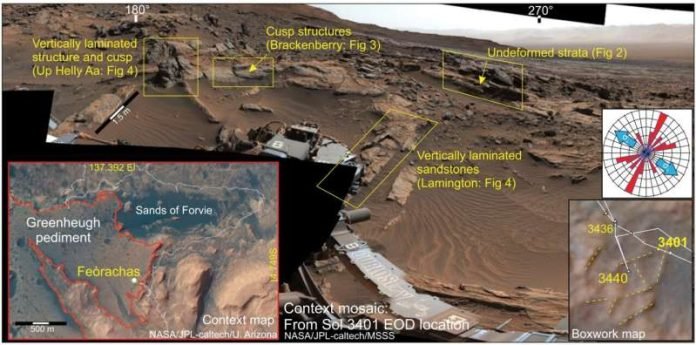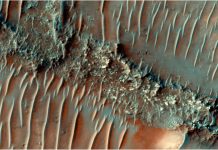
In a new discovery, scientists led by Imperial College London have uncovered evidence suggesting that water existed on Mars within the Gale crater long after it was believed the planet had turned into the arid, dusty landscape we know today.
This revelation not only challenges our understanding of Mars’ climate history but also opens up new possibilities in the search for signs of life on the Red Planet.
NASA’s Curiosity rover, which has been exploring Mars since 2012, played a crucial role in this research. By analyzing data and images from the rover, the team identified peculiar formations within a desert sandstone in the Gale crater.
These formations, according to the researchers, could only have been shaped by the presence of water—whether as pressurized liquid, ice, or brine remains uncertain.
This discovery suggests that water was present on Mars more recently and for a longer duration than previously believed.
“This water might have been pressurized liquid, forced into and deforming the sediment; frozen, with the repeat freezing and thawing process causing the deformation; or briny, and subject to large temperature swings,” explained Dr. Steven Banham, the study’s lead author.
The Gale crater, with its 154km diameter, is located just south of Mars’ equator and once housed a lake.
The team’s findings, published in the journal Geology, propose that water remained abundant underground, near the surface of Mars, well into the later Hesperian period—3.7 to 3.0 billion years ago, a time when most surface water was thought to have vanished.
Curiosity’s journey through the Gale Crater and the northern flank of Mount Sharp has been instrumental in piecing together Mars’ climatic history.
The crater’s central mountain, built from layers of lake, river, and later, desert sediments, provides a unique record of the planet’s transition from a wet, habitable environment to a dry desert.
The study focused on the Stimson Formation, a layer of sandstone that draped over Mount Sharp, deposited during Mars’ drying phase.
Curiosity’s Mastcam instrument captured images of this formation, revealing structures deformed by water—evidence contradicting the belief that Mars was completely dry during this period.
“These structures point to the presence of water just below the surface,” said Amelie Roberts, a co-author of the study and Ph.D. candidate from Imperial College London.
The discovery of water-formed structures in what was thought to be a period of aridity suggests that the Gale crater region, and possibly Mars itself, remained habitable for a longer time than previously assumed.
This finding has significant implications for future Mars exploration, especially in the search for biosignatures, or signs of past life.
Desert sandstones like the Stimson Formation, previously overlooked as potential sites for finding evidence of life, now emerge as promising targets for exploration.
“Our findings reveal new avenues for exploration—shedding light on Mars’ potential to support life and highlighting where we should continue hunting for new clues,” Dr. Banham added.
While signs of life have yet to be discovered on Mars, this research extends the timeline for water’s presence on the planet, suggesting that Mars could have supported life for longer than we thought.
The research findings can be found in Geology.
Copyright © 2024 Knowridge Science Report. All rights reserved.



